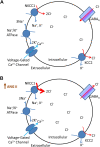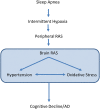Role of angiotensin II in chronic intermittent hypoxia-induced hypertension and cognitive decline
- PMID: 33595364
- PMCID: PMC8238144
- DOI: 10.1152/ajpregu.00222.2020
Role of angiotensin II in chronic intermittent hypoxia-induced hypertension and cognitive decline
Abstract
Sleep apnea is characterized by momentary interruptions in normal respiration and leads to periods of decreased oxygen, or intermittent hypoxia. Chronic intermittent hypoxia is a model of the hypoxemia associated with sleep apnea and results in a sustained hypertension that is maintained during normoxia. Adaptations of the carotid body and activation of the renin-angiotensin system may contribute to the development of hypertension associated with chronic intermittent hypoxia. The subsequent activation of the brain renin-angiotensin system may produce changes in sympathetic regulatory neural networks that support the maintenance of the hypertension associated with intermittent hypoxia. Hypertension and sleep apnea not only increase risk for cardiovascular disease but are also risk factors for cognitive decline and Alzheimer's disease. Activation of the angiotensin system could be a common mechanism that links these disorders.
Keywords: GABA; SA; SNA; angiotensin II; hypertension; sleep apnea; sympathetic nerve activity.
Conflict of interest statement
No conflicts of interest, financial or otherwise, are declared by the authors.
Figures



Similar articles
-
Angiotensin II type 1a receptors in subfornical organ contribute towards chronic intermittent hypoxia-associated sustained increase in mean arterial pressure.Am J Physiol Heart Circ Physiol. 2015 Mar 1;308(5):H435-46. doi: 10.1152/ajpheart.00747.2014. Epub 2014 Dec 24. Am J Physiol Heart Circ Physiol. 2015. PMID: 25539713 Free PMC article.
-
Neural Control of Blood Pressure in Chronic Intermittent Hypoxia.Curr Hypertens Rep. 2016 Mar;18(3):19. doi: 10.1007/s11906-016-0627-8. Curr Hypertens Rep. 2016. PMID: 26838032 Free PMC article. Review.
-
Angiotensin type 1a receptors in the median preoptic nucleus support intermittent hypoxia-induced hypertension.Am J Physiol Regul Integr Comp Physiol. 2019 May 1;316(5):R651-R665. doi: 10.1152/ajpregu.00393.2018. Epub 2019 Mar 20. Am J Physiol Regul Integr Comp Physiol. 2019. PMID: 30892911 Free PMC article.
-
AT1a-dependent GABAA inhibition in the MnPO following chronic intermittent hypoxia.Am J Physiol Regul Integr Comp Physiol. 2021 Sep 1;321(3):R469-R481. doi: 10.1152/ajpregu.00030.2021. Epub 2021 Jun 30. Am J Physiol Regul Integr Comp Physiol. 2021. PMID: 34189959 Free PMC article.
-
Invited review: Physiological consequences of intermittent hypoxia: systemic blood pressure.J Appl Physiol (1985). 2001 Apr;90(4):1600-5. doi: 10.1152/jappl.2001.90.4.1600. J Appl Physiol (1985). 2001. PMID: 11247966 Review.
Cited by
-
Pulmonary Vascular Responses to Chronic Intermittent Hypoxia in a Guinea Pig Model of Obstructive Sleep Apnea.Int J Mol Sci. 2024 Jul 8;25(13):7484. doi: 10.3390/ijms25137484. Int J Mol Sci. 2024. PMID: 39000591 Free PMC article.
-
Brain nitric oxide and inflammation in chronic intermittent hypoxia: Contributors to cognitive impairment and hypertension.Brain Behav Immun Health. 2025 Aug 4;48:101077. doi: 10.1016/j.bbih.2025.101077. eCollection 2025 Oct. Brain Behav Immun Health. 2025. PMID: 40808977 Free PMC article. Review.
-
RNA sequencing reveals circular RNA expression patterns in chronic intermittent hypoxia.Sleep Biol Rhythms. 2025 Feb 19;23(3):295-303. doi: 10.1007/s41105-025-00577-w. eCollection 2025 Jul. Sleep Biol Rhythms. 2025. PMID: 40538387
-
The new mechanism of cognitive decline induced by hypertension: High homocysteine-mediated aberrant DNA methylation.Front Cardiovasc Med. 2022 Oct 24;9:928701. doi: 10.3389/fcvm.2022.928701. eCollection 2022. Front Cardiovasc Med. 2022. PMID: 36352848 Free PMC article. Review.
-
Chronic Intermittent Hypoxia reveals role of the Postinspiratory Complex in the mediation of normal swallow production.bioRxiv [Preprint]. 2024 Mar 13:2023.09.26.559560. doi: 10.1101/2023.09.26.559560. bioRxiv. 2024. Update in: Elife. 2024 Apr 24;12:RP92175. doi: 10.7554/eLife.92175. PMID: 37808787 Free PMC article. Updated. Preprint.
References
Publication types
MeSH terms
Substances
Grants and funding
LinkOut - more resources
Full Text Sources
Other Literature Sources
Medical
Research Materials

